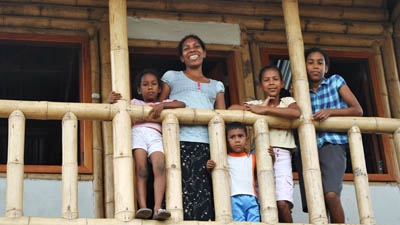“I like my new house because unlike in my aunt’s house, where we used to live, there’s no more leaks; no mosquitoes get in; no mud comes in when it rains; and especially because it’s not too hot or too cold,” says Lilibeth Abad, the oldest of five siblings of a family living in Monte Sinaí, a poor neighborhood of Guayaquil.
Like Lilibeth, many families have improved their living conditions thanks to the housing they received from the project “Elevated Bamboo Houses to Protect Communities in Flood Zones.” These houses are built of caña guadúa, a type of bamboo native to Ecuador.
Eugenia, a single mother of four, also mentioned that the new house has made life easier because previously, besides washing clothes, cleaning houses and selling food to support her family, she had to deal with problems associated with the frequent floods triggered by the torrential rains typical of Ecuador’s rainy season, which is between December and June.
Today, the project of the International Network for Bamboo and Rattan (INBAR), financed by the World Bank, has built a variety of structures. These include two shelters, three classrooms and five houses, which have given people like Eugenia and Lilibeth dignified, safe dwellings for themselves and their families.
INBAR and the Corporación Hogar de Cristo, partners in the implementation of the project, have created four different housing prototypes in marginal urban areas of Guayaquil. These houses, which are elevated a few meters above the ground, are not only flood-resistant, but also provide other benefits thanks to the Ecuadorean bamboo, such as maintaining stable temperatures and low humidity levels.

